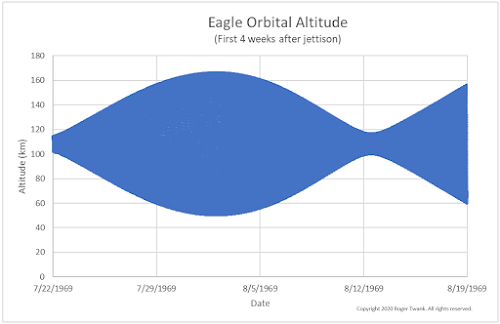The simulation environment I am using, GMAT, doesn’t know anything about the Moon’s mountains or valleys. When it calculates the altitude of an orbit, that altitude is relative to the “mean radius” of the Moon, somewhat comparable to “sea level” on Earth. So far, in the simulations I have run for the Eagle and Snoopy, that hasn’t mattered, because the orbits of both objects remain high above the surface. But to estimate the location of a possible impact, as for the Apollo 16 subsatellite, we have to do a deeper analysis. In this post I’ll explain how that works.
Let's start with the big picture. An orbit has become more eccentric…the high point of the orbit has moved higher, and the low point of the orbit has moved lower. On Earth, as the spacecraft began to skim the atmosphere, it would slow down, then burn up, and the heaviest bits might make it all the way to the surface. Since the Moon has no atmosphere, the spacecraft, at the low point of its orbit, can zip past the lunar surface at very low altitude, moving more than a mile per second, and if it misses the surface, even barely, it can continue around for another pass.
 |
| Figure 1: The path of a spacecraft passing low over the Moon's surface |
 |
| Figure 2: Ground track file excerpt. The terrain and "AGL" altitude data (in km) was added by post-processing the output from the simulator. |
Step one is to go through the ground track, one line at a time. From the latitude and longitude, we can look up the nearest terrain altitude point in the elevation model. Once we know the spacecraft altitude and the terrain
height, we can calculate its “Above Ground Level” altitude. I
write out a new copy of the ground track file with the extra terrain altitude
and “AGL” data points added to each line, like the yellow values shown in the figure above. To limit the size of the new file I discard any point where the spacecraft is more than 5 km above the surface.
Here is a plot of a ground track file showing two low revolutions of a spacecraft over an area of the Moon. One thing to notice right away, even though this is covering 30 degrees of longitude, or a distance of about 900 km, the "zero" altitude point is flat, and the satellite trajectory curves upward, away from the Moon. This is just to make it easier to plot out the data. I promise the Moon is NOT flat, and the spacecraft is always curving towards the center of the Moon, as in Figure 1 above. The flattening of the Moon for this chart doesn't affect our ability to find the impact point. Another thing to keep in mind is that the vertical scale is greatly exaggerated. This chart is 900 km wide and just 8 km high.
 |
| Figure 3: A "flattened" plot of low passes of a spacecraft over the Moon. The area in the green box depicts the values highlighted in green from Figure 2. |
Figure 3 allows us to see the areas where the spacecraft is coming close to the surface of the Moon. In particular, the points in the small green box highlight the closest approach visible at this resolution, and the closest point shows a separation of 449 meters above the ground. Given that these two data points are separated by a distance of over 20 km, we need to zoom in and take a closer look.
 |
| Figure 4: A "zoomed in" look at the region of the green box from Figure 3. We see that the spacecraft altitude is lower than the terrain altitude at 98.97°. Kaboom! |
The figure above shows the zoomed in view. The two red dots are the points from the green box of Figure 3, the same data points highlighted in the ground track file in Figure 2. What we have done is to make a straight line between these points, and break that line into 100 shorter segments, like the dotted blue line. (This process is called linear interpolation.) For each blue dot we can again look up the terrain altitude and compare it to the spacecraft altitude. Sure enough, in that intervening 20 km between the two red points there was a mountain, about 800 meters tall, and the spacecraft (moving from right to left in this example) strikes it near its top, at around 98.97°.
How do we know there wasn't another mountain lurking somewhere further to the East? We don't! We have to check. In my code, posted here, I check any time I find a point that is within 3 km of the ground. (I also tried higher thresholds, but 3 km seems to be sufficient to catch all the lurking mountains in my tests so far.)
This is how I have used GMAT to estimate the impact location of the Apollo 16 Particles and Fields Subsatellite, the notorious (in some circles) PFS-2. Now that I have this tool working, I am interested to use it to investigate another Apollo impact. Yes, there is another spacecraft from the Apollo era whose final resting place is unknown...the ascent stage of the Apollo 16 Lunar Module "Orion". As I write these words the 50th anniversary of that mission is fast approaching. Stand by for further updates.




























